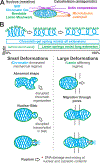Chromatin's physical properties shape the nucleus and its functions
- PMID: 30889417
- PMCID: PMC6692209
- DOI: 10.1016/j.ceb.2019.02.006
Chromatin's physical properties shape the nucleus and its functions
Abstract
The cell nucleus encloses, organizes, and protects the genome. Chromatin maintains nuclear mechanical stability and shape in coordination with lamins and the cytoskeleton. Abnormal nuclear shape is a diagnostic marker for human diseases, and it can cause nuclear dysfunction. Chromatin mechanics underlies this link, as alterations to chromatin and its physical properties can disrupt or rescue nuclear shape. The cell can regulate nuclear shape through mechanotransduction pathways that sense and respond to extracellular cues, thus modulating chromatin compaction and rigidity. These findings reveal how chromatin's physical properties can regulate cellular function and drive abnormal nuclear morphology and dysfunction in disease.
Copyright © 2019 Elsevier Ltd. All rights reserved.
Figures

Similar articles
-
Chromatin rigidity provides mechanical and genome protection.Mutat Res. 2020 May-Dec;821:111712. doi: 10.1016/j.mrfmmm.2020.111712. Epub 2020 Jun 17. Mutat Res. 2020. PMID: 32590202 Free PMC article. Review.
-
Nuclear shape, mechanics, and mechanotransduction.Circ Res. 2008 Jun 6;102(11):1307-18. doi: 10.1161/CIRCRESAHA.108.173989. Circ Res. 2008. PMID: 18535268 Free PMC article. Review.
-
Nuclear mechanotransduction: sensing the force from within.Curr Opin Cell Biol. 2017 Jun;46:119-127. doi: 10.1016/j.ceb.2017.04.004. Epub 2017 Jun 20. Curr Opin Cell Biol. 2017. PMID: 28641092 Review.
-
The nucleus feels the force, LINCed in or not!Curr Opin Cell Biol. 2019 Jun;58:114-119. doi: 10.1016/j.ceb.2019.02.012. Epub 2019 Apr 16. Curr Opin Cell Biol. 2019. PMID: 31002996 Review.
-
Physicochemical mechanotransduction alters nuclear shape and mechanics via heterochromatin formation.Mol Biol Cell. 2019 Aug 1;30(17):2320-2330. doi: 10.1091/mbc.E19-05-0286. Mol Biol Cell. 2019. PMID: 31365328 Free PMC article.
Cited by
-
Evolution and Comparative Genomics of the Transforming Growth Factor-β-Related Proteins in Nile Tilapia.Mol Biotechnol. 2024 Sep 6. doi: 10.1007/s12033-024-01263-x. Online ahead of print. Mol Biotechnol. 2024. PMID: 39240458
-
Chromatin rigidity provides mechanical and genome protection.Mutat Res. 2020 May-Dec;821:111712. doi: 10.1016/j.mrfmmm.2020.111712. Epub 2020 Jun 17. Mutat Res. 2020. PMID: 32590202 Free PMC article. Review.
-
Stress as a Chromatin Landscape Architect.Front Cell Dev Biol. 2021 Dec 14;9:790138. doi: 10.3389/fcell.2021.790138. eCollection 2021. Front Cell Dev Biol. 2021. PMID: 34970548 Free PMC article. Review.
-
DNA damage causes ATM-dependent heterochromatin loss leading to nuclear softening, blebbing, and rupture.Mol Biol Cell. 2025 Mar 1;36(3):br6. doi: 10.1091/mbc.E24-05-0232. Epub 2024 Dec 20. Mol Biol Cell. 2025. PMID: 39705376 Free PMC article.
-
The destruction of cytoplasmic skeleton leads to the change of nuclear structure and the looseness of lamin A submicroscopic network.Heliyon. 2024 Sep 7;10(18):e36583. doi: 10.1016/j.heliyon.2024.e36583. eCollection 2024 Sep 30. Heliyon. 2024. PMID: 39309767 Free PMC article.
References
-
- Reddy KL, Zullo JM, Bertolino E, Singh H: Transcriptional repression mediated by repositioning of genes to the nuclear lamina. Nature 2008, 452:243–247. - PubMed
-
-
Tajik A, Zhang Y, Wei F, Sun J, Jia Q, Zhou W, Singh R, Khanna N, Belmont AS, Wang N: Transcription upregulation via force-induced direct stretching of chromatin. Nat Mater 2016, 15:1287–1296.
*Stress applied to the cell surface with a magnetic bead propagated force into the nucleus and stretched chromatin, causing an increase in transcription of stretched genes. Thus, external stresses can directly regulate gene expression.
-
Publication types
MeSH terms
Substances
Grants and funding
LinkOut - more resources
Full Text Sources
Other Literature Sources

